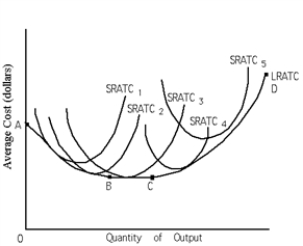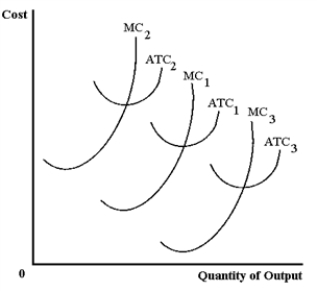A) explicit costs.
B) implicit costs.
C) sunk costs.
D) the sum of explicit and implicit costs.
Correct Answer

verified
Correct Answer
verified
Multiple Choice
Which of the following situations would prompt individuals to try to form a team (firm) , according to Alchian and Demsetz.
A) Jones, Smith, and Brown together produce 100 units of good X each day working alone and 90 units of good X each day working together.
B) Jones, Smith, and Brown together produce 100 units of good X each day working alone and 120 units of good X each day working together.
C) Jones, Smith, and Brown together produce 100 units of good X each day working alone and 100 units of good X each day working together.
D) Jones produces more working alone than Smith or Brown produce working alone.
E) Jones produces more working as a member of a team than Smith or Brown produce working as a member of a team.
Correct Answer

verified
Correct Answer
verified
Multiple Choice
Exhibit 21-5
 -Refer to Exhibit 21-5. The minimum efficient scale is at
-Refer to Exhibit 21-5. The minimum efficient scale is at
A) point A.
B) point B.
C) point C.
D) point D.
E) points B and C.
Correct Answer

verified
Correct Answer
verified
True/False
A firm that earns zero accounting profit is earning a normal profit.
Correct Answer

verified
Correct Answer
verified
Multiple Choice
Suppose that one fixed and one variable input are used to produce good X. As the marginal physical product of the variable input increases, the marginal cost
A) increases.
B) decreases.
C) remains constant.
D) There is not enough information to answer the question.
Correct Answer

verified
Correct Answer
verified
True/False
Economies of scale are exclusively a long-run phenomenon, while the law of diminishing marginal returns applies to both the short-run and to the long-run.
Correct Answer

verified
Correct Answer
verified
Multiple Choice
Exhibit 21-9
 -Refer to Exhibit 21-9. Let MC1 and ATC1 represent the initial cost curves of a peanut butter producer. In which of the following cases is it most likely that the firm's curves will shift leftward to MC2 and ATC2?
-Refer to Exhibit 21-9. Let MC1 and ATC1 represent the initial cost curves of a peanut butter producer. In which of the following cases is it most likely that the firm's curves will shift leftward to MC2 and ATC2?
A) The market price of peanuts decreases.
B) There is an improvement in technology in the production of peanut butter.
C) The government raises taxes paid by peanut butter producers.
D) a and b
Correct Answer

verified
Correct Answer
verified
Multiple Choice
A cost that is incurred when an actual monetary payment is made is a(n) __________ cost.
A) explicit
B) implicit
C) positive
D) expressed
Correct Answer

verified
Correct Answer
verified
Multiple Choice
A rising marginal cost curve is a reflection of a
A) rising marginal physical product curve.
B) falling marginal physical product curve.
C) falling average fixed cost curve.
D) rising average variable cost curve.
Correct Answer

verified
Correct Answer
verified
Multiple Choice
Exhibit 21-7
 -Refer to Exhibit 21-7. The average total cost of producing 4 units of output is
-Refer to Exhibit 21-7. The average total cost of producing 4 units of output is
A) $11.25.
B) $5.00.
C) $3.50.
D) $27.50.
E) There is not enough information to answer this question.
Correct Answer

verified
Correct Answer
verified
Multiple Choice
 -What is the relationship between the average fixed cost (AFC) curve and the marginal cost (MC) curve?
-What is the relationship between the average fixed cost (AFC) curve and the marginal cost (MC) curve?
A) The MC curve intersects the AFC curve at its minimum point.
B) When the MC curve is above the AFC curve, AFC must be increasing.
C) Both a and b are true.
D) There is no relationship between the AFC curve and the MC curve..
Correct Answer

verified
Correct Answer
verified
Multiple Choice
If labor is the variable input, then marginal cost equals
A) MPP divided by the wage rate.
B) average variable (labor) costs divided by MPP.
C) average variable (labor) costs multiplied by MPP.
D) the wage rate divided by MPP.
E) the wage rate multiplied by MPP.
Correct Answer

verified
Correct Answer
verified
Multiple Choice
If the LRATC curve is falling, then
A) the law of diminishing marginal returns is operating.
B) economies of scale are present.
C) constant returns to scale are present.
D) diseconomies of scale are present.
Correct Answer

verified
Correct Answer
verified
Multiple Choice
 -Refer to Situation 21-3. What are the total costs?
-Refer to Situation 21-3. What are the total costs?
A) $88,000
B) $2,400
C) $32,000
D) $56,000
E) There is not enough information to answer the question.
Correct Answer

verified
Correct Answer
verified
Multiple Choice
Suppose a given marginal cost curve starts out downward sloping and at some level of output turns upward and becomes upward sloping. The point at which it turns upward is the point at which
A) marginal physical product increases.
B) total cost rises.
C) average fixed cost declines.
D) average variable cost is below marginal cost.
E) diminishing marginal returns set in.
Correct Answer

verified
Correct Answer
verified
Multiple Choice
Exhibit 21-3
 -Refer to Exhibit 21-3. The marginal cost figures in blanks (I) and (J) , respectively, are
-Refer to Exhibit 21-3. The marginal cost figures in blanks (I) and (J) , respectively, are
A) $5.33 and $10.00.
B) $1.33 and $2.00.
C) $1.33 and $1.43.
D) $13.33 and $20.
E) none of the above
Correct Answer

verified
Correct Answer
verified
Multiple Choice
Exhibit 21-10

-Refer to Exhibit 21-10. Which of the students has the highest marginal productivity for the fifth hour of studying?
-Refer to Exhibit 21-10. Which of the students has the highest marginal productivity for the fifth hour of studying?
A) Jose
B) Paul
C) Marisol
D) both Paul and Marisol
Correct Answer

verified
Correct Answer
verified
Multiple Choice
The marginal cost curve passes through the __________ curve at its lowest point.
A) average variable cost
B) average total cost
C) average fixed cost
D) a and b
E) a, b, and c
Correct Answer

verified
Correct Answer
verified
Multiple Choice
Minimum efficient scale refers to the
A) smallest plant size a firm can utilize and still maintain production.
B) lowest point on a given SRATC curve.
C) output level at which the LRATC curve touches each SRATC curve.
D) lowest output level at which average total costs are minimized.
Correct Answer

verified
Correct Answer
verified
Multiple Choice
Exhibit 21-5
 -Refer to Exhibit 21-5. Diseconomies of scale are present between
-Refer to Exhibit 21-5. Diseconomies of scale are present between
A) points A and B.
B) points A and C.
C) points B and C.
D) points B and D.
E) points C and D.
Correct Answer

verified
Correct Answer
verified
Showing 41 - 60 of 245
Related Exams